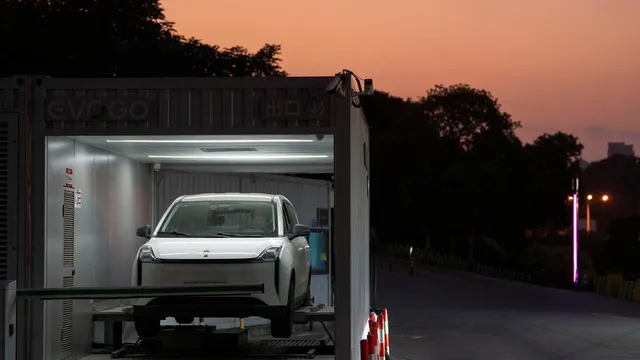
CATL plans to raise over $4 billion in Hong Kong listing
2025-05-12 00:00- CATL initiated a secondary listing in Hong Kong to raise over $4 billion.
- The company is facing challenges with U.S. investment restrictions amid geopolitical tensions.
- The successful execution of the plan is crucial for CATL's strategic expansion efforts.
Express your sentiment!
Insights
In May 2025, Contemporary Amperex Technology (CATL), the world's largest maker of electric vehicle batteries, embarked on a major capital-raising effort through a second listing in Hong Kong. The company aimed to raise at least HK$31.01 billion, approximately $4 billion, by offering 117.9 million shares at a maximum price of HK$263 each. Interest in the offering is significant, with more than 20 cornerstone investors, including Sinopec and Kuwait Investment Authority, poised to contribute approximately $2.62 billion by committing to buy shares. This move marks the most substantial new share sale in Hong Kong for the year, underlining CATL's aggressive expansion strategy amid a shifting global battery market. The deal could be further enhanced through an offer size adjustment option and a greenshoe option, which could boost the total size to approximately $5.3 billion. The company’s decision to proceed with the listing comes in the context of building a new factory in Hungary, which represents an investment of €7.6 billion, aiming to create nearly 10,000 jobs locally. Despite its strong market position, CATL faces challenges, particularly in relation to U.S.-China geopolitical tensions. U.S. onshore investors are restricted from participating in the Hong Kong listing, which may affect the overall demand. This situation stems from recent designations that have classified CATL as a “Chinese Military Company,” although CATL has denied any associations with military activities. As a result, significant concerns regarding regulatory and reputational risks have emerged, impacting the company’s ability to engage with U.S. investors directly. Furthermore, the prospectus notes the evolving landscape of U.S. tariffs and their potential impact on the company’s operational revenues. However, CATL asserts that only a minimal portion of its revenue is generated from exports of China-made products to the United States. The company is adapting by licensing its battery technology to key U.S. clients, such as Ford and Tesla, to aid their developments while facing scrutiny from U.S. lawmakers regarding its business practices. As public trading is set to begin on May 20, the outcome of CATL's listing will be pivotal for its strategic goals moving forward.
Contexts
The impact of U.S. tariffs on Chinese companies has been a significant area of focus since the implementation of trade policies in recent years. These tariffs originated from trade imbalances and allegations of unfair practices, leading to increased costs for Chinese exporters when doing business with the United States. Consequently, Chinese companies faced heightened scrutiny, forcing them to rethink their pricing strategies and operational models to maintain competitiveness in the U.S. market. As tariffs were introduced, affected companies had to consider alternatives, such as shifting supply chains, enhancing local production capabilities, or seeking markets outside the U.S. to mitigate losses. This shift has not only affected the financial health of these companies but has also led to broader implications for the Chinese economy by influencing foreign direct investment and employment rates in trading sectors reliant on the U.S. market. Moreover, the uncertainty surrounding tariff policies led to a tangible change in business behavior. Many Chinese firms increased their investments in technology and innovation to boost productivity, aiming to offset the rising costs induced by tariffs. A prime example can be seen in the electronics and technology sectors, where companies adapted by formulating new partnerships and exploring alternative trade agreements with other nations. The trade dynamics changed significantly as businesses focused on diversifying their markets, leading to a more globalized approach while reducing dependency on the U.S. market. Furthermore, smaller Chinese companies, particularly those without substantial resources, were disproportionately affected, risking their sustainability amidst tightening profit margins. It is essential to recognize that while U.S. tariffs imposed challenges, they also served as a catalyst for some transformative practices within Chinese firms. Adaptation strategies evolved, including automation and improving supply chain efficiencies, as companies sought to retain their market shares and optimize costs. As a result, some sectors, like manufacturing, demonstrated resilience and growth as firms refined their operational strategies. The tariffs created disparities in competitive advantage, where larger, more resourceful companies were better suited to weather the financial pressures than smaller counterparts. This prolonged economic tension illustrated the broader implications of international trade policies on domestic business practices within China. Ultimately, the long-term consequences remain deeply intertwined with U.S.-China relations, and companies are now navigating an environment defined by volatility and unpredictability. While some Chinese firms successfully adapted to tariffs by redirecting their strategies, others faced severe capital constraints, leading to their exit from the U.S. market. In a global context, these tariff impacts underscore the interconnectedness of international business landscapes and highlight the need for ongoing adjustments in policy and trade negotiations. The experiences of Chinese companies offer invaluable insights into the resilience of businesses operating under duress and the importance of adaptability in the face of economic policies.